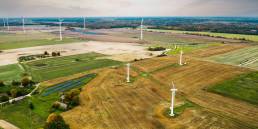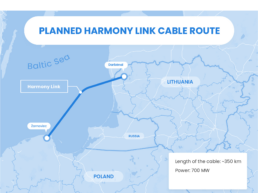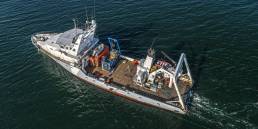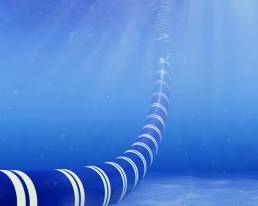ABOUT THE PROJECT
What is Harmony Link?
Harmony Link is a new Lithuanian-Polish electricity interconnector that will connect the Zarnowiec substation in the Pomeranian region of Poland with the Darbėnai substation in the Kretinga region of Lithuania. The key component of the interconnector is a 700 MW High Voltage Direct Current (HVDC) cable. The power link will be about 330 km long, of which about 290 km will be the offshore part.
The submarine cable will improve the region’s energy security by providing a trading function after the synchronisation of the Lithuanian, Latvian and Estonian electricity systems with the Continental European Synchronous Area (CESA). In addition, Harmony Link will increase the reliability of energy supply to consumers throughout the region.
Preparatory work for Harmony Link has been underway since early 2019.
The investors in the project are the Polish and Lithuanian electricity transmission system operators, Polskie Sieci Elektroenergetyczne SA (PSE) and Litgrid.
Project data
- Territory: the Baltic Sea (the exclusive economic zones of Lithuania, Poland, and Sweden, the territorial sea of Poland, the territorial sea of Lithuania), the territory of Lithuania (Kretinga and Palanga municipalities), the territory of Poland (Krokowa commune)
- The starting point of the planned connection: the Darbėnai substation, Žynelių village, Kretinga district municipality.
- End of planned connection: the Zarnowiec substation in Krokowa commune, the Pomeranian region of Poland.
- The total length of the link: 330 km
- Capacity: 700 MW
- Financing: The total investment planned for the Harmony Link project is around €680 million, of which €493 million will come from the Connecting Europe Facility.
Project implementation
The submarine interconnection with Poland is the largest project of Baltic States synchronisation with Continental European Synchronous Area (CESA). It will significantly increase the energy security of all three Baltic States and contribute to the future integration of renewable energy sources.
The main preparatory work for the Harmony Link was completed in early autumn 2021, with the preparation of a route study in the Baltic Sea, the signing of contracts for the link and targeted consultations, a seabed survey, and the completion of the spatial planning procedures.
Under the cooperation agreement (IPCA) on the project implementation model signed between Litgrid and PSE in May 2020, the operators share responsibility for the work to be carried out by each party.
Litgrid will be responsible for the procurement of the HVDC cable, the selection of the contractor, and the signing and implementation of the bilateral contract.
PSE will be responsible for the procurement, selection of the contractor, signing, and implementation of the bilateral contract for the HVDC converter stations in Lithuania and Poland.
Each country will pay 100% of the cost of installing the onshore cable through its territory, plus the total cost of installing the respective converter station and will split the cost of installing the offshore part of the cable in half. The operators also envisage jointly procuring the services of a Employers Representative and entering into a trilateral service contract for the supervision of the project’s contract works.
The agreement between Litgrid and PSE also defines the ownership of the interconnector: the converter station in Lithuania, the onshore cable section, and 50% of the offshore cable will be owned by Litgrid, while PSE will own the HVDC converter station in Poland, as well as the onshore cable section in Poland and 50% of the offshore cable. The contract will be valid until Harmony Link becomes operational.
Preparatory work for Harmony Link has been underway since early 2019. A route study in the Baltic Sea was completed by January 2020, and intensive spatial planning work was carried out from December 2019 to 2021.
Litgrid and PSE conducted surveys of the Baltic Sea seabed in 2021 in the area where the interconnector cable is to be laid. The tender documents for the construction of the cable and the converter stations were also submitted in 2021, and the feasibility study for the project has already been completed.
Key dates and events
- On 22 June 2018, during the European Council meeting, a historic agreement on the Political Roadmap leading to the implementation of the synchronisation project was signed at a special ceremony.
- On 21 December 2018, the heads of Lithuanian and Polish transmission system operators Litgrid and Polskie Sieci Elektroenergetyczne (PSE) have signed an agreement to start the preparatory phase of a new Lithuanian-Polish offshore HVDC cable project. The representatives of Lithuania and Poland have decided to name the new offshore link Harmony Link.
- On 7 August 2019, the Lithuanian Government approved a list of 14 synchronisation projects and granted them the status of exceptional national importance. One of the projects is the construction of the Harmony Link.
- On May 2020 Litgrid and PSE signed a cooperation agreement for the implementation phase of the Harmony Link project, committing the operators to contribute equally to the installation of the offshore link.
- In December 2020, the Baltic and Polish TSOs signed a financing agreement with the European Commission to finance the second phase of Baltic synchronisation (including Harmony Link Interconnector). The Connecting Europe Facility provided €720 million.
- In January 2021, the offshore and onshore routes for Harmony Link in Lithuania were selected, and the site for the Darbėnai substation was acquired.
- The feasibility study was completed in Q1 2021.
- Report on seabed geophysical, geotechnical and environmental surveys along the route of the cable were completed in Q3 2021, and the final offshore route of the cable was specified
- Tenders for the construction of the interconnector cable and converter stations were launched in Q3 2021.
Project funding
The Harmony Link project represents an investment of around €680 million, of which €493 million comes from the Connecting Europe Facility (CEF).
Lithuania and Poland will pay 100% of the installation costs of the onshore cable crossing their territories and the total cost of installing the converter station. In contrast, the cost of installing the offshore part of the cable will be split in half. The operators of the Parties also envisage jointly procuring the services of a customer representative and entering into a tripartite service contract to supervise the project’s contract works.
Project benefits
Synchronisation with Continental European Synchronous Area (CESA) grids is the important strategic project for Lithuania, Latvia and Estonia. Baltic States electricity system is still dependent on frequency control in Russia, but by 2025 it will be operating in a single synchronous area with other European countries.
Synchronisation will take place through the existing link between Lithuania and Poland (LitPol Link), while the new Harmony Link offshore link will unlock the economic potential of synchronising the Baltic electricity systems with Continental Europe. Harmony Link will be the last synchronisation project and the first cross-border project to fully integrate elements of the same synchronous area.
With its technical capacity, the submarine cable asynchronously connects Lithuania and Poland, which remains an essential prerequisite for full integration into the European synchronous area without reducing trading capacity in the single European electricity market.
The main benefits of the Harmony Link project are:
- Strengthening energy security in the Baltic States and the north-eastern region of Poland.
- Increasing the opportunities for electricity exchanges on the European market.
- Synchronisation of the Baltic electricity systems with the Continental European system.
- Increasing the capacity of the electricity grid for local consumers and producers.
- Promoting investment in the region.
- Annual real estate tax to be paid into municipal budgets.
- Integration of offshore wind.
Studies
The studies and surveys provide the information needed for the crucial Harmony Link project: data necessary for the construction and protection of the cable and the analysis of objects on the seabed, including hazardous wrecks and remnants of war munitions.
The environmental analysis helps assess the potential impact of the link on the Baltic Sea environment and ensures that the best result in sustainability is achieved.
The spatial planning and environmental impact assessment processes required for Harmony Link are also ongoing.
Useful links
- Website of Lithuanian transmission system operator Litgrid.
- Website of the Polish transmission system operator Polskie Sieci Elektroenergetyczne.
- For more information on synchronisation, see the Synchronisation section of the Litgrid.eu website.
HOW DOES AN INTERCONNECTOR WORK?
Strategic electricity projects
Long-term
partnership
Litgrid and PSE have already implemented strategic electricity projects together. LitPol Link, which became operational in 2015, connected the electricity infrastructures of the Baltic States and Western Europe for the first time. The powerful electricity link with Poland opens up the possibility of synchronous operation with the energy systems of other Western European countries. Moreover, it enables the development of a single European electricity market. More information on the project.
Harmony Link is the largest and most complex of all the projects to synchronize the Baltic States with the Continental European Synchronous Area. It has been prepared responsibly and involves partners with extensive experience and high competencies.
The construction of the 700 MW High Voltage Direct Current (HVDC) link cable is a key part of the Harmony Link project. The HVDC cable will connect the Zarnowiec substation in the Pomerania region of Poland with the Darbėnai substation in the Kretinga region of Lithuania.
The main project parameters are:
- 700 MW and 100 MW of temporary congestion capacity,
- ±350 MVAr,
- ±320 kVDC,
- approximately 330 km of DC cable.
The main elements of the Harmony Link project are the HVDC cable and the HVDC converters. The converters are manufactured using today’s advanced VVC manufacturing technology with symmetrical monopole. A cable system consisting of a HVDC cable and fiber optic cables is required for the approximately 330 km long cable route.
The route includes approximately:
- 290 km of submarine cable,
- 20 km of underground cable routes in Poland and Lithuania.
The scope of work for the Harmony Link project is divided into two parts (the cable system and the substations for the HVDC converters).









